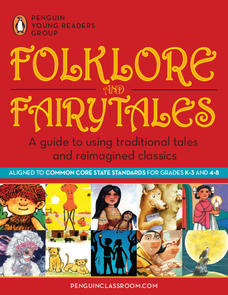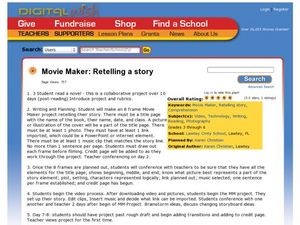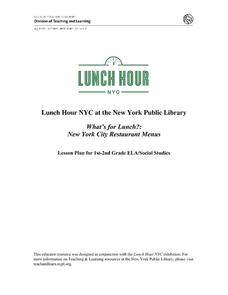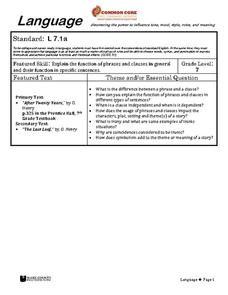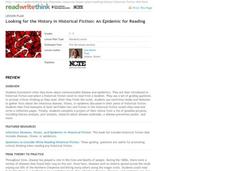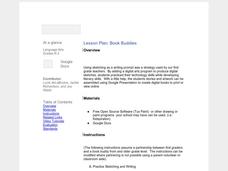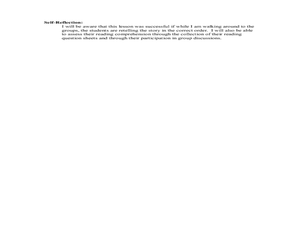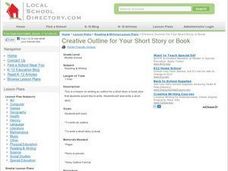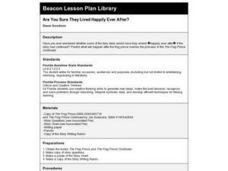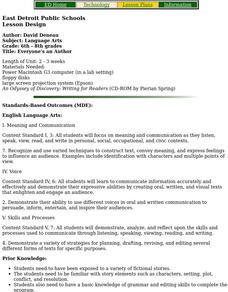Curated OER
During Reading Strategy: Literary Newspaper
Add some writing to your class's reading of Cold Sassy Tree! With this plan, readers assume the role of journalist and create a segment of a paper with their peers. Suggested segments are included, and a worksheet dividing the text into...
Curated OER
Analyzing Literary Devices
Eighth graders identify figurative language and poetry in this literary analysis lesson. Using Through the Looking Glass by Lewis Carroll and a YouTube video for "The Walrus and the Carpenter," young readers complete a literary device...
Penguin Books
Folklore and Fairytales: A Guide to Using Traditional Tales and Reimagined Classics
Every culture has its own stories to tell. An interesting educator's guide shares a large collection of fairytales and folktales, some from different cultures and some re-creations of classics. A summary and brief teaching ideas...
Curated OER
Movie Maker: Retelling a Story
Using Movie Maker, sixth graders make an eight frame movie based on a story they have written. They choose music clips, select pictures from PowerPoint, and make their movie. The lesson should take about ten days to complete.
Hawaiʻi State Department of Education
Poems That Dance
Combine the elements of dance with the actions in a poem. Learners review basic grammar, write an action-packed cinquain poem, and then choreograph a dance based on their cinquains. After the dances are done, they'll discuss the elements...
Curated OER
The Study of Theme and Figurative Language in Poetry and/or Prose
Identify and analyze the use of figurative language used in select pieces of writing. These pieces of literature will represent at least two pieces by one writer and at least two pieces by different writers. This lesson would be a great...
Curated OER
Hot and Cold Colors
Students experiment with the color and solar energy absorption. In this color and solar energy absorption lesson, students spend two days discussing and experimenting with the concept of energy absorption. They paint cans with different...
New York Public Library
What's for Lunch?: New York City Restaurant Menus
Do you remember the days when a cup of coffee cost five cents? At A.W. Dennett restaurant in 1894, you could buy a five-cent cup of coffee and as well as a five-cent slice of pie to accompany it. The menu from that year is a primary...
Wake County Public Schools
Language
Have your class doing everything from reading literature, analyzing literary devices, identifying independent and dependent clauses, discussing, and writing creatively with the rich resource found here. After a mini lesson on independent...
Curated OER
Shizuko’s Daughter: Story Impression
Craft your own fairy tale based on Momotaro, a Japanese story referenced in Kyoko Mori's Shuzuko's Daughter. A list of nouns guide learners in writing their own story, and predicting what might happen in the novel.
ReadWriteThink
Looking for the History in Historical Fiction: An Epidemic for Reading
Combine informational reading skills with fictional text in an innovative historical fiction lessons. After reading a fictional text related to diseases, class members read non-fictional text to gain knowledge about specific infectious...
Curated OER
Amos and Boris: Text Study
Twenty insightful questions follow a read aloud of the story, Amos and Boris by William Steig. Scholars then show what they know through completion of a cause and effect chart, reading fluency assessment, and a written...
Curated OER
My Favorite Story
Students share their pictures on an online database. As a class, they discuss their favorite books and why they like it. They review the elements of a story and brainstorm ideas for each category. To end the lesson, they complete a...
Curated OER
Book Buddies
Students read a book and share a book review with an e-mail book buddy once a month. They word process the review, copy and paste into the e-mail for sharing.
Curated OER
The Little Hungry Caterpillar
Students discuss "The Little Hungry Caterpillar." In this reading comprehension lesson plan, students make sock caterpillars used in retelling the story so as sequence the events accurately.
Curated OER
Writing the Mystery with a Purpose
Learners present the outline of the mystery story they are writing while working in reciprocal teaching groups. They respond to group members writing before they continue to finish revisions.
Curated OER
Creative Outline for Your Short Story or Book
Students discuss the information listed about how to make an outline for a short story or book. They then begin writing their short story and edit it and revise before turning it in to be graded.
Curated OER
Giving An Oral Book Report
Students study techniques used to give an oral book report. They read their book, plan their thoughts, and write their report. Students present their book report to the class.
Curated OER
Are You Sure They Lived Happily Ever After?
Students listen to a read aloud of Jon Scieszka's, The Frog Prince. They predict what happens after the frog prince marries his princess.
Curated OER
A Midsummer Night's Dream by William Shakespeare
Young scholars read and perform William Shakespeare's A Midsummer Night's Dream. In this Shakepeare play activity, students read the script for the play and practice the simplified version of the play.
Curated OER
Everyone's an Author
Students examine variety of written pieces of quality fiction, discuss what different story elements are present and how those elements make stories as effective as they are, and create a class story.
Curated OER
Photo Essay
Learners examine the process of writing a photo essay. They examine and select a personal photo or photo from a magazine, and brainstorm a story that can go with the photo. They identify an emotion to go with their picture, then write...
Curated OER
The Red Convertible
Students read and discuss the short story "The Red Convertible". They participate in extension activities related to each of the three parts of the story, planning a road trip, researching the Vietnam War, and writing a paper on their...
Curated OER
Establishing a Point of View in Narratives
Fourth graders investigate the concept and take the opportunity to both identify and to construct point of view in narratives. Additionally, 4th graders practice identifying and sequencing main events.


